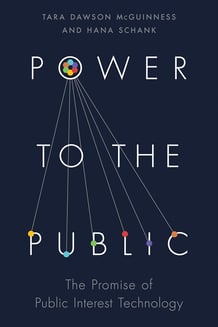Book Review: Power to the Public: The Promise of Public Interest Technology by Hana Schank and Tara Dawson McGuinness
Hana Schank and Tara Dawson McGuinness have created something special. Their book, Power to the Public, offers a refreshing perspective on how technology can improve government for everyone. As someone who has read my fair share of dry policy books, I was pleasantly surprised by how engaging this one was.
BOOK REVIEWTECHNOLOGYSTATE & LOCAL GOVERNMENTFEDERAL GOVERNMENT
Dr. Shawn Granger
2/24/20252 min read


First, let me say how nice it is to read a book about technology and government that doesn't make you sleepy. Schank and McGuinness have a gift for explaining complex ideas to ordinary people in ways that make sense. They avoid getting lost in technical jargon and instead focus on telling a story about how technology can transform our public systems.
Available at AMAZON or anywhere books are sold.
The authors strike an excellent balance between a realistic assessment of the challenges and hope for the future. Reading the book feels like conversing with smart friends passionate about improving government—not trudging through a textbook.
Real Stories That Make You Think "This Could Actually Work"
What grabbed me were the stories of real-world successes. Instead of just theorizing, the authors show us places where tech has improved government.
Take the U.S. Digital Service, for example, a team of tech experts who rolled up their sleeves and fixed broken systems like healthcare.gov and the VA claims process. Or consider how New York City transformed its 311 system so people could track their complaints about potholes or noise issues in real-time. These aren't just abstract ideas; they're proof that good design and thoughtful tech implementation can make a real difference in people's lives.
It's Not Just About Fancy Tech—It's About People
One thing I appreciated about this book is how it emphasizes that successful public-interest technology isn't just about having the latest gadgets. It's about designing systems that work for the people who need them most.
The authors repeatedly reiterate the idea that technology should be built with users in mind, especially those historically left behind. They make a compelling case for involving diverse voices in the design of these systems rather than imposing solutions from the top down.
I love how they describe data not just as cold numbers but as a powerful tool that can help governments understand what citizens need. When used correctly, data can make services more responsive, efficient, and fair.
A Nudge to Get Involved
By the book's end, you will feel informed and inspired to think about how you might contribute to this movement. The authors don't just explain problems—they invite readers to become part of the solution.
They convincingly argue that creating better public systems requires collaboration between the government, tech companies, and regular citizens. They offer practical suggestions for getting involved and emphasize the need for diverse perspectives in the tech workforce.
Worth Your Time
Whether you work in government or tech or are just a citizen who cares about how public services function, this book offers something valuable. It's an optimistic but grounded look at how thoughtfully applied technology can help create a government that works for everybody.
What sticks with me most is the authors’ vision of a future where technology serves the common good—not by replacing human judgment but by enhancing our ability to solve complex public problems together. In a time when many of us feel frustrated with government systems that don't work as they should, "Power to the Public" offers both practical solutions and a renewed sense of possibility.


